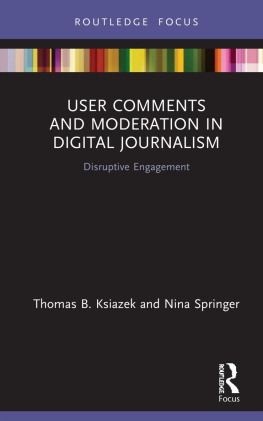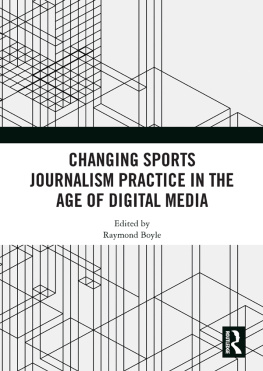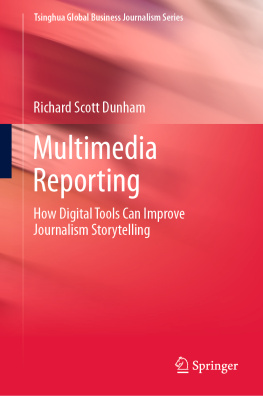Hyperlocal Journalism and Digital Disruptions
At a time when digital technologies are impacting on the success and sustainability of traditional models of journalism, hyperlocal journalism seeks to restore journalistic integrity, build community, incite change and engage audiences. This book argues for the increased importance of these new forms of localized reporting in the digital age.
Hyperlocal Journalism and Digital Disruptions begins with the fundamental question of what hyperlocal journalism is, then focuses on three case studies which illustrate its potential to thrive when the right balance is struck between audience engagement, investment and respect. Each case study examines a different start-up in Australia and New Zealand. Although the notion of hyperlocal journalism is not new, the ways in which these regionalized stories are now being told has evolved. This book demonstrates the increased necessity for tailored approaches to creating and providing hyperlocal journalism in order to engage targeted audiences, meet their needs for news and reclaim authenticity and credibility for journalism.
This is a valuable resource for researchers, academics, students and practitioners in the areas of Digital Journalism and Media Studies generally.
Scott Downman is a journalist and lecturer at the University of Queensland. For the past 15 years he has been involved in community development projects in Southeast Asia and Australia that use media and journalism to address complex social issues and that experiment with alternative forms of storytelling.
Richard Murray is a former journalist. He is now a PhD student and sessional lecturer in journalism at the University of Queensland.
Disruptions: Studies in Digital Journalism
Series editor: Bob Franklin
Disruptions refers to the radical changes provoked by the affordances of digital technologies that occur at a pace and on a scale that disrupts settled understandings and traditional ways of creating value, interacting and communicating both socially and professionally. The consequences for digital journalism involve far-reaching changes to business models, professional practices, roles, ethics, products and even challenges to the accepted definitions and understandings of journalism. For Digital Journalism Studies, the field of academic inquiry which explores and examines digital journalism, disruption results in paradigmatic and tectonic shifts in scholarly concerns and prompts reconsideration of research methods, theoretical analyses and responses (oppositional and consensual) to such changes, which have been described as being akin to a moment of mind-blowing uncertainty.
Routledges new book series, Disruptions: Studies in Digital Journalism, seeks to capture, examine and analyse these moments of exciting and explosive professional and scholarly innovation which characterise developments in the day-to-day practice of journalism in an age of digital media, and which are articulated in the newly emerging academic discipline of Digital Journalism Studies.
Hyperlocal Journalism and Digital Disruptions
Scott Downman and Richard Murray
Hyperlocal Journalism and Digital Disruptions
The journalism change agents in Australia and New Zealand
Scott Downman and Richard Murray
First published 2018
by Routledge
2 Park Square, Milton Park, Abingdon, Oxon OX14 4RN
and by Routledge
711 Third Avenue, New York, NY 10017
Routledge is an imprint of the Taylor & Francis Group, an informa business
2018 Scott Downman and Richard Murray
The right of Scott Downman and Richard Murray to be identified as authors of this work has been asserted by them in accordance with sections 77 and 78 of the Copyright, Designs and Patents Act 1988.
All rights reserved. No part of this book may be reprinted or reproduced or utilised in any form or by any electronic, mechanical, or other means, now known or hereafter invented, including photocopying and recording, or in any information storage or retrieval system, without permission in writing from the publishers.
Trademark notice: Product or corporate names may be trademarks or registered trademarks, and are used only for identification and explanation without intent to infringe.
British Library Cataloguing-in-Publication Data
A catalogue record for this book is available from the British Library
Library of Congress Cataloging-in-Publication Data
A catalog record for this book has been requested
ISBN: 978-1-138-04408-1 (hbk)
ISBN: 978-1-315-17263-7 (ebk)
Typeset in Times New Roman
by Apex CoVantage, LLC
Since the new millennium journalism has been in a state of flux. Traditional, or legacy media as it has become known, has been grappling with the digital ecosystem that now defines and shapes global journalism. Some major media outlets have collapsed, while others have seen dramatic audience losses. It has caused media executives to rationalise newsrooms, experiment with new forms of storytelling and wrestle with the problem of making money in a social media-driven market. Beyond these structural issues, it has caused some to reflect on how to produce journalism. In the digital field, there are now many journalisms, vying for acceptance, authenticity and, most importantly, an audience. Niche journalism, participatory journalism, citizen journalism, alternative journalism, slow journalism, geosocial journalism, engaged journalism, reciprocal journalism the list goes on. In the midst of digital disruption, and countless journalisms, a grassroots journalism has emerged hyperlocal journalism. Hyperlocal journalism seeks to provide targeted, niche news to local communities. It also seeks to build community, incite change and engage audiences. Hyperlocal journalism is fundamentally focussed on fulfilling journalisms Fourth Estate function. But its more than that. It is journalism that is focussed first and foremost on the audience. The audiences needs, the audiences engagement in the news production process and the audiences empowerment are crucial elements in the hyperlocal journalism model. Picone (2007) says it is news dedicated to a defined neighbourhood, ZIP code or interest group within a certain geographic space. Because of this, hyperlocal journalism is a malleable and organic model that must adapt in nuanced ways to serve its target community. A one-size-fits-all approach cannot be applied to the hyperlocal journalism model. But one thing that is evident in all hyperlocal journalism approaches is that it involves reimagining and challenging traditional models of reporting and community engagement. This includes rethinking the way stories are sourced, the way news is gathered and the involvement of the audience in the news production process.









